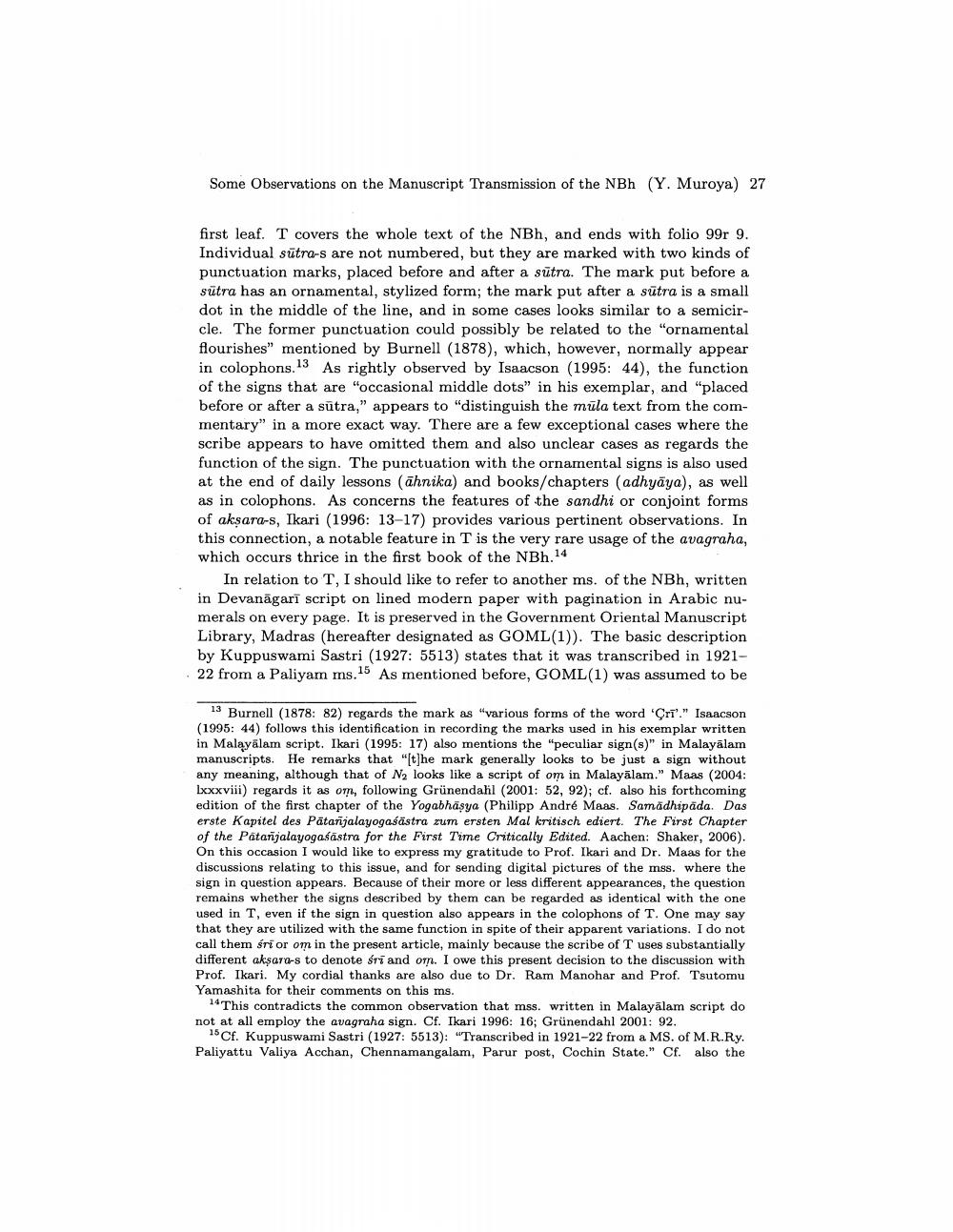Book Title: Some Observations On Manuscript Transmission Of Nyayabhasya Author(s): Yasutaka Muroya Publisher: Yasutaka Muroya View full book textPage 5
________________ Some Observations on the Manuscript Transmission of the NBh (Y. Muroya) 27 first leaf. T covers the whole text of the NBh, and ends with folio 99r 9. Individual sūtra-s are not numbered, but they are marked with two kinds of punctuation marks, placed before and after a sutra. The mark put before a sütra has an ornamental, stylized form; the mark put after a sütra is a small dot in the middle of the line, and in some cases looks similar to a semicircle. The former punctuation could possibly be related to the "ornamental flourishes" mentioned by Burnell (1878), which, however, normally appear in colophons. 13 As rightly observed by Isaacson (1995: 44), the function of the signs that are "occasional middle dots" in his exemplar, and "placed before or after a sutra," appears to "distinguish the mula text from the commentary" in a more exact way. There are a few exceptional cases where the scribe appears to have omitted them and also unclear cases as regards the function of the sign. The punctuation with the ornamental signs is also used at the end of daily lessons (āhnika) and books/chapters (adhyāya), as well as in colophons. As concerns the features of the sandhi or conjoint forms of akşara-s, Ikari (1996: 13-17) provides various pertinent observations. In this connection, a notable feature in T is the very rare usage of the avagraha, which occurs thrice in the first book of the NBh.14 In relation to T, I should like to refer to another ms. of the NBh, written in Devanāgarī script on lined modern paper with pagination in Arabic numerals on every page. It is preserved in the Government Oriental Manuscript Library, Madras (hereafter designated as GOML(1)). The basic description by Kuppuswami Sastri (1927: 5513) states that it was transcribed in 192122 from a Paliyam ms. As mentioned before, GOML(1) was assumed to be 13 Burnell (1878: 82) regards the mark as "various forms of the word 'Crī'." Isaacson (1995: 44) follows this identification in recording the marks used in his exemplar written in Malayalam script. Ikari (1995: 17) also mentions the "peculiar sign(s)" in Malayalam manuscripts. He remarks that "[t]he mark generally looks to be just a sign without any meaning, although that of N2 looks like a script of om in Malayālam." Maas (2004: Lxxxviii) regards it as om, following Grünendahl (2001: 52, 92); cf. also his forthcoming edition of the first chapter of the Yogabhāsya (Philipp André Maas. Samadhipäda. Das erste Kapitel des Patañjalayogaśästra zum ersten Mal kritisch ediert. The First Chapter of the Patañjalayogaśāstra for the First Time Critically Edited. Aachen: Shaker, 2006). On this occasion I would like to express my gratitude to Prof. Ikari and Dr. Maas for the discussions relating to this issue, and for sending digital pictures of the mss. where the sign in question appears. Because of their more or less different appearances, the question remains whether the signs described by them can be regarded as identical with the one used in T, even if the sign in question also appears in the colophons of T. One may say that they are utilized with the same function in spite of their apparent variations. I do not call them sri or om in the present article, mainly because the scribe of T uses substantially different aksara-s to denote sri and om. I owe this present decision to the discussion with Prof. Ikari. My cordial thanks are also due to Dr. Ram Manohar and Prof. Tsutomu Yamashita for their comments on this ms. 14 This contradicts the common observation that mss. written in Malayālam script do not at all employ the avagraha sign. Cf. Ikari 1996: 16; Grünendahl 2001: 92. 16 Cf. Kuppuswami Sastri (1927: 5513): "Transcribed in 1921-22 from a MS. of M.R.Ry. Paliyattu Valiya Acchan, Chennamangalam, Parur post, Cochin State." Cf. also thePage Navigation
1 ... 3 4 5 6 7 8 9 10 11 12 13 14 15 16 17 18 19 20 21 22 23 24 25 26 27 28 29 30 31 32 33 34 35 36 37 38 39 40 41 42
